#ernie colón
Text

Ghosts #109 - DC, February 1982.
Cover art by Ernie Colón.
92 notes
·
View notes
Text

Eerie #22 ‘H2O World!’, ‘Family Curse’, ‘The Devil to Pay!’, ‘Permanent Members!’, ‘Scooped!’ and ‘The Spirit of the Thing!’ (1969) by Archie Goodwin, Neal Adams, Tom Sutton, Larry Ivie, Al Williamson, Bill Parente, Ernie Colón and many more. Edited by Parente. Cover by Vic Prezio.
#eerie#eerie magazine#warren publishing#warren magazines#archie goodwin#neal adams#tom sutton#larry ivie#al williamson#bill parente#ernie colón#ernie colon#vic prezio#horror#horror magazines#comics
6 notes
·
View notes
Text
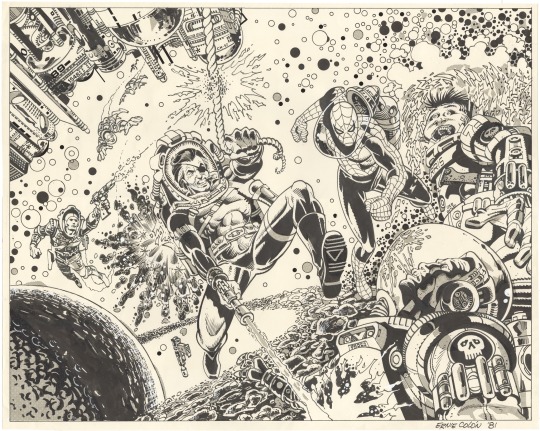
Ernie Colón, Nick Fury and Spidey.
10 notes
·
View notes
Photo
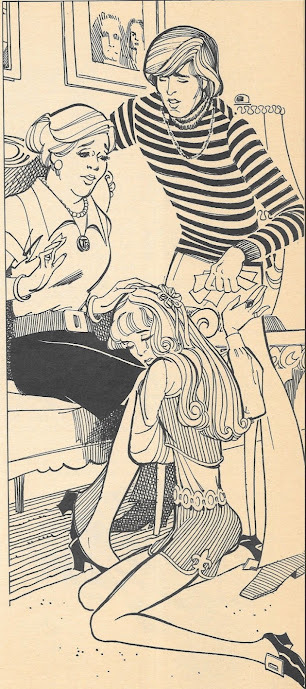
(via BOOKSTEVE'S LIBRARY: Ernie and CeeCee)
art by Ernie Colón
22 notes
·
View notes
Photo
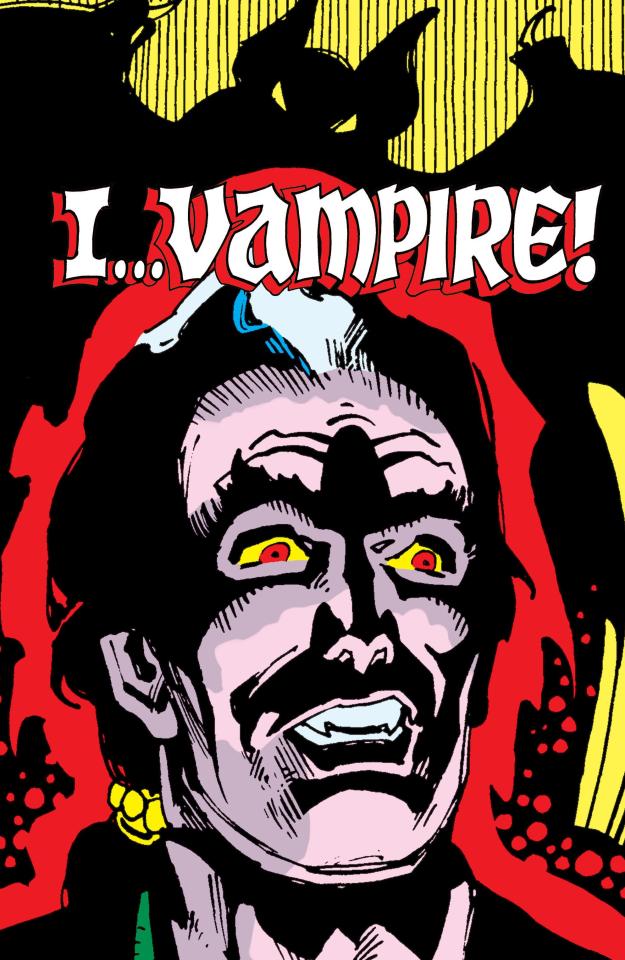
10 notes
·
View notes
Text

Released on this date in 1983, Legion of Super-Heroes #300 by Paul Levitz and Keith Giffen featured a host of guest artists that included Kurt Schaffenberger, Howard Bender, Curt Swan, Dave Cockrum, James Sherman, Joe Staton and Larry Mahlstedt.
The characters on the cover itself were drawn by a whole bunch of different artists:
Carmine Infantino and Bob Oksner (Supergirl), Paris Cullins (Invisible Kid), George Pérez (Colossal Boy), Joe Kubert (Dawnstar), Kurt Schaffenberger (Superboy), José Luis García-López (Sun Boy), Don Heck (White Witch), Jim Aparo (Karate Kid), Jan Duursema (Queen Projectra), Gene Colan and Frank Giacoia (Timber Wolf), Dave Cockrum (Phantom Girl), Walter Simonson (Blok), George Tuska and Mike DeCarlo (Star Boy), James Sherman (Dream Girl), Howard Chaykin (Brainiac 5), Curt Swan (Ultra Boy), Howard Bender and Dave Hunt (Wildfire), Keith Giffen and Larry Mahlstedt (Cosmic Boy), Dick Giordano (Saturn Girl), Mahlstedt and Giffen (Lightning Lad), Gil Kane (Mon-El), Trevor Von Eeden (Element Lad), Joe Orlando (Chameleon Boy), Ross Andru and Romeo Tanghal (Shadow Lass), Ernie Colón (Duo Damsel), Joe Staton (Bouncing Boy), and Giffen and Dan Adkins (Proty II).
And the extra-length story itself featured several possible futures for the Legion, as well as guest appearances by just about everyone associated with the team, including Superboy and Supergirl.
0 notes
Text

Khimera Puzzle Island
Super Mario RPG
Venineth
Grapple Dog
Lone Fungus
The Iron Claw
Wonka
Fitzcarraldo
The Other Side of the Wind
Sculpting in Time by Andrey Tarkovsky, translated by Kitty Hunter-Blair
Batman: The Dark Knight Returns 30th Anniversary Edition by Frank Miller with Klaus Janson and Lynn Varley
Batman: Justice Buster Vol. 1 by Eiichi Shimizu and Tomohiro Shimoguchi
Damage Control: The Complete Collection by Dwayne McDuffie, Ernie Colón, Kyle Baker, Salva Espin, et. al.
Berserk Deluxe Edition Vol. 2 by Kentaro Miura
Neptune's Lair by Drexciya
A1 - D1 by Gescom
Hidden Cinema Soundtrack by Foehn
Named by EOD
Accelerator by The Future Sound of London
Harnessed the Storm by Drexciya
Moog Grooves by Edd Kalehoff
When in Dream by El Huervo
Grava 4 by Drexciya
Journey of the Deep Sea Dweller I by Drexciya
Journey of the Deep Sea Dweller II by Drexciya
Journey of the Deep Sea Dweller IV by Drexciya
Blood Sweat and Fear by Scattle
Mini Disc by Gescom
ISS:SA by Gescom
EAP Tracks by EOD
Questionmarks by EOD
Swurlk EP by EOD
Warmwoods by EOD
Rayline EP by EOD
Zone by EOD
Clean Pit & Lid by Disjecta
N-Plants by Biosphere
BBLO by Jinjé
Amya by Jinjé
Special Dry by Jinjé
The Finest by Jinjé
Be Yourself by Jinjé
Solace by Jinjé
We Need More Heart by Jinjé
Feetupfeetdown by Jinjé
I'm Psychic by Jinjé
Are Those Really Birds? by Jinjé
Single Minded by Jinjé
No Luxury by Jinjé
Closer to the Sun by Jinjé
A Ship Full of Ghosts by Jinjé
All but a Glimmer by Jinjé
Boost by Astrid Sonne
How Far by Astrid Sonne
Staying here by Astrid Sonne
Do you wanna by Astrid Sonne
Microgravity by Biosphere
Polar Sequences by Higher Intelligence Agency and Biosphere
Insomnia by Biosphere
Nordheim Transformed by Arne Nordheim, Biosphere, and Deathprod
Cirque by Biosphere
Substrata 2 by Biosphere
Shenzou by Biosphere
Autour de la Lune [Reissue] by Biosphere
Birmingham Frequencies by Biosphere and Higher Intelligence Agency
Compilation 1991-2004 by Biosphere
L'incoronazione di Poppea by Biosphere
Patashnik 2 by Biosphere
Patashnik (Reissue with Bonus Album) by Biosphere
Departed Glories by Biosphere
The Hilvanrenbeek Recordings by Biosphere
The Senja Recordings by Biosphere
Angel's Flight by Biosphere
Shortwave Memories by Biosphere
Inland Delta by Biosphere
Ask the Ages by Sonny Sharrock
Conder-Rhyptik by Oberman Knocks
Beatcroff Slabs by Oberman Knocks
Beatcroff Slabs Remix EP by Oberman Knocks
Dilankex EP by Oberman Knocks
Trilate Shifts by Oberman Knocks
Remhex Coyles EP by Oberman Knocks
Rehmunvhurse Optikonn EP by Oberman Knocks
Songs about Fucking Steve Albini by Kid606
Split Series #10 by Christoph de Babalon and Kid606
Down with the Scene by Kid606
ps I love you by Kid606
ps you love me by Kid606
Why I Love Life by Kid606
Kill Sound Before Sound Kills You by Kid606
Who Still Kill Sound? by Kid606
Resilience by Kid606
Pretty Girls Make Raves by Kid606
Die Soundboy Die by Kid606
Shout at the Döner by Kid606
Don't Sweat the Technics++ (1997-1998) by Kid606
Let's Get Radioactive (Or How I Learned to Stop Worrying and Love Nuclear Energy) by Kid606
Lost in the Game by Kid606
Lost in the Game (Remixes) by Kid606
Happiness by Kid606
We Love You Mark Bell by Kid606
Waves of Now by Steve Roach and Robert Rich
Great Doubt by Astrid Sonne
Hitomi Tohyama - Night Tempo Presents the Shows Groove by Hitomi Tohyama and Night Tempo
0 notes
Text
Comics read this past week:
Marvel Comics:
Black Widow: The Coldest War (1990)
This 62-page graphic novel was published in April 1990, according to the Marvel Wiki, and was written by Gerry Conway, penciled by George Freeman, and inked by Mark Farmer, George Freeman, Mark Harris, Val Mayerik, Joe Rubinstein, and Ernie Colón.
The majority of this story took place in 1987, during the Cold War, with the epilogue taking place in 1990 when one of the villains of the main story, who has since become a politician, contacts Natasha with an offer for her to perform in Russia as a ballerina. She tells Nick Fury, “He says they want me to come home, Nick.” He reminds her that the Cold War is over and she’s free to do what she wants and she say, “I know, Nick. We’re all free now… And it’s glorious.”
Fury/Black Widow: Death Duty (1995) #1
This 64-page one-shot was published in February 1995, according to the Marvel Wiki, and was written by Cefn Ridout and drawn by Charlie Adlard.
This story actually had Natasha going back to Russia after the end of the Cold War in her capacity as a S.H.I.E.L.D. agent. She’s supposed to be working with the police there, but the relationship is strained. Apparently the U.S. government threatened to withhold I.M.F. loans if they didn’t accept her help with the case. Meanwhile, Natasha suspects that the police has been paid off by the mafia and investigates behind their backs, which the main person she’s supposed to be working with, Colonel Yuri, accuses her of. In the end it was another person that was working with Yuri that had been paid off and Yuri dies shielding Natasha from gunfire, proving his virtuousness.
At the end of the story Natasha tells Nick Fury, “The new Russia’s not what I expected. I left because the system was destroying the country. Now, the system’s gone, I’m not sure it’s for the best- I’m still a stranger, here.” He tells her, “Give it time, ‘Tash. At least you’ve got a choice.”
Captain America (2005) #26-27
With these Captain America issues I went from May 2007 to June 2007, according to the Marvel Wiki. They were written by Ed Brubaker, penciled by Steve Epting, and inked by Mike Perkins. Both were 22 pages.
I’m really enjoying where this book is going. When Sharon had previously talking about her job in issue #22 (as she was being mentally warped by Dr. Faustus), she stressed how important it was to her and specifically that it ordinarily wouldn’t be more important to her than Steve. In issue #26 she explains her reason for quitting as, “What’s the point, anyway… without Steve?” In issue #27 she tries to kill herself, thinking, “You don’t deserve to live now, and you know it,” referring to how Dr. Faustus made her kill Steve. But Dr. Faustus has made it impossible for her to kill herself or to tell anyone what she did. By the end of the issue she’s started working with Sam under Nick Fury’s direction and I’m really curious as to where that’s going to go, if that’s something that Dr. Faustus is pushing her to do and so she’s going to secretly working against them or if she’s going to try to communicate with them that she killed Steve indirectly and be able to foil whatever Dr. Faustus and the Red Skull’s plans with her are.
I’m also liking what’s happening with Bucky. In issue #26 Nick Fury calls Sam to intervene with Bucky and he gets there just as Bucky is finishing up a bar fight, which he instigated because someone there insulted Steve. I like that Nick Fury was apparently keeping an eye on Bucky. But at the end of the issue Bucky decides that he going to kill Tony Stark, which puts him on the opposing side of Nick. I really love this, even though I don’t have any animosity towards Tony myself, because I’m enjoying how intense Bucky is getting as he commits to this plan.
And issue #27 is when it was first established that Bucky and Natasha Romanoff have a history. Natasha was tasked with protecting Steve’s shield which Bucky wanted to steal to make sure no one else can use it because he doesn’t think anyone else is worthy. As they fight Bucky thinks, “By the time I see my move, I’m actually wishing this was one of Karpov’s missions… And that those damned machines would be waiting when I finished… to wipe my memories away again.” It’s revealed that Bucky actually helped train Natasha. Flashbacks depict the two of them secretly meeting up together, getting caught, and then Natasha breaking into where Bucky was held afterwards and horrifyingly finding him frozen. I’m expecting that we are getting to get more information about these revealing but contextless moments in the upcoming issues.
Black Widow (2004) #1-6
These issues were published across October 2004 to February 2005, according to the Marvel Wiki. They were written by Richard K. Morgan and drawn by Bill Sienkiewicz, with Goran Parlov drawing the layouts for all but issue #1. Issues #1-2 and #6 were 22 pages and issues #3-5 were 23 pages.
This was the book that first established that Natasha was raised in the Red Room and wasn’t just trained there as an adult, retconning her previous backstory, including being trained as a ballerina at the Bolshoi, as part of their mental conditioning. Things fall apart pretty quickly once she gets to Russia in issue #5. She goes to the Bolshoi to see her old teacher, only to be told that no one with that name has ever worked there. She’s able to figure out where she was actually trained by recognizing a sign she had seen out a window in her youth and when inside finds the remains of the room where she was brainwashed, which triggers flashbacks, as well as someone who had played a part in that process and is able to explain most everything to her. It’s explained that part of the conditioning is that Natasha becomes sick if she tries to think logically about her memories. Even so, I disliked how simple it was to point out the falsity, with just the question, “Well, if you were a Bolshoi ballerina, for one thing, your feet would be horribly maimed from all the dancing on blocks. They’re not though, are they?” It’s hard to me to accept that no one ever noticed that before, or that there wasn’t any record of Natasha training at the Bolshoi, or that Natasha apparently didn’t train as a ballerina at all and so wouldn’t know how to dance at a professional level as an adult. It’s also not at all addressed what this means for the non-Bolshoi parts of Natasha’s backstory, like Ivan Petrovitch, who was previously portrayed as someone who saved Natasha’s life when she was a baby and then become a father figure to her and was featured prominently as a loyal ally of Natasha’s in both of the 90s Black Widow stories I read this week, and her husband Alexei Shostokoff, who’s “death” motivated her to become a spy in the first place as an adult and then who’s real death cemented her defection to the United States.
When Natasha brings up Yelena Belova she’s told, “Oh- her. Oh my goodness, no. Belova was a, an aberration. Nothing to do with the real Black Widow program. I believe she models fetish lingerie these days.” I was shocked and upset by this flippant dismissal of Yelena’s entire character. The Red Room was first mentioned when Natasha and Yelena first met in Black Widow (1999) #1 and Yelena says, “I am a student from the Red Room in Moscow. You remember it, then? Yes, I thought you would. And yes, it is still active.” And then, “It is you who will call me Black Widow. That’s right. I am the first student in the history of the Red Room to surpass your marks.” When we last left Yelena off in Black Widow: Pale Little Spider (2002) she was being manipulated by her superiors to get over her concern that she wasn’t on Natasha’s level and so wasn’t the true Black Widow, which she’d been intensely arguing she was in Black Widow (1999) and Black Widow (2001). The closing line of Pale Little Spider in issue #3, in response to that statement that if Yelena ever found out about their manipulations that she would betray them, was that they could always make another Black Widow. That she’s supposed to just be a fetish lingerie model now was particularly inappropriate to me considering that Yelena has been established to be really uncomfortable with sex, but even regardless of that I would think that this is a sexist way to write off a character that had previously only been portrayed as, while inexperienced, a dedicated and competent agent and had a really interesting dynamic with Natasha.
This book actually tried very hard to say something poignant about sexism. There’s a scene in issue #1 where Natasha talks to Phil Dexter about how most women face a lack of options between being a “pole dancer or a hard-faced harridan,” which, she says, “Is Madonna or whore. It’s just the Madonna got promoted- on condition she’s twice as tough and twice as smart as any man she’s dealing with.” When Phil asks if she’s that woman, Natasha says, “Let’s hope so.” I think that this would read a lot stronger if it was connected to specific events, even if they were just invented for the sake of this story, that are specific to Natasha’s character. I’m referring to facing sexist limitations that genuinely impeded her when she was younger in Russia or within the superhero field or at S.H.I.E.L.D. Because Natasha is meant to be this legendary supremely competent super-spy, though in this book she is repeatedly dismissed as just a woman. As it is, I don’t understand Natasha’s lack of certainty in herself at this point. I don’t understand how she would think other people’s expectations of women would limit her or why she would be concerned that she’s not tough or smart enough. If anything, I would think, while annoying, being underestimated would be helpful.
While that conversation was happening, Natasha and Phil ignore a young woman trying to hitchhike on the highway. Later Natasha saves that young woman from being raped from the truckers who did pick her up, killing one of the men and paralyzing the other in the process. The young woman, Sally Anne, ends up tagging along for the rest of the book and we learn that she was running away from home because her stepfather became “overly friendly” and her mother stood by and did nothing to stop him. In issue #3 Sally Anne says that she thinks all men are scum and Natasha agrees with her because in that specific moment she’s frustrated with Phil and because she just got done interrogating a man with truth serum, during which, besides the information that she needed, she also prompted him into confessing to having an affair with a 17-year-old in front of his wife. When that man later comes falling out a window it’s unknown if he chose to jump, but Natasha says, “Personally, I’d like to think he was pushed.” I was actually surprised that there wasn’t more resistance to the expressed man-hating sentiments, like, say, Natasha later taking back her agreement that all men are scum. Phil and Sally Anne form a positive relationship over time, but that’s inherently complicated. Regarding them intervening when Sally Anne was going to be raped, Phil says, which is contrasted against how Sally Anne’s own mother didn’t help her, “Ah, well, ahem, I wasn’t going to just stand by and just watch, was I?” But we, the audience, know that he was going to just stand by, that he tried to convince Natasha not to do anything, and that he was upset with her for it afterwards.
In issue #3, when Natasha and Sally Anne both recognize the name of a cosmetics company and Phil hasn’t heard of them, Sally Anne says, “Of course you haven’t- you’re a guy.” This prompts Natasha to go on a monologue about how men aren’t pressured to care about their looks, that she’s not interested in cosmetics, that she spends her money on things like books and rock climbing gear, but the last present she was given was perfume because, “I’m a woman, and that’s what women are supposed to value above all else. Cosmetic appearance.” This was weird to me. She’s clearly drawn wearing bright red lipstick throughout the entire book, which is not to mention the matching pair of lingerie-like black lacy panties and bra she apparently casually wears under her clothes all the time. Natasha not convincingly portrayed as as someone who does not spend time (and money) on her cosmetic appearance. I'm not sure if she was meant to just care about women being defined by their physical appearances for herself or for it to be a broader political opinion. Natasha cares about Sally Anne throughout the book, in issue #4 it's implied she's worried about Sally Anne becoming a prostitute, but also in issue #1 Natasha opens a phone call with Phil with, “You’re answering your own phone. What happened to the latest blonde? Silicon leak?”
In issue #2 there’s a scene where Natasha and Phil talk and Phil stays fully clothed but Natasha gets undressed to change outfits. This gives us two pages where the main adult characters have a serious conversation but one of them, the woman, is just wearing lacy underwear. In issue #3 Natasha does actually wear very little with a purpose, in order to seduce a man to get information she needs from him. In her description of him she says that he has “impeccable alpha male credentials” and that his weakness is the usual one. She complains internally, “Heels you can barely walk in, let alone run. Skin exposed all over, regardless of weather. A look that says ‘take me I’m yours.’ Dressed to be killed, more like.” She ties the man up in his bed, seemingly as preparation for them to have sex, but then she doses him with a truth serum and a hallucinogen that makes cry out for his mommy. When she’s gotten what she needs she leaves him tied up there, assuming that it, “Won’t do his reputation any harm when they find him like this. Never does if you’re a guy.” This feels like it’s trying to have it both ways, featuring the character in a sexy framing while also criticizing the difference between standards of men and women’s appearances and sexual activity at the same time, which is a bit discordant and doesn’t come across as properly specific to this character. I do think that there's something interesting that could be done with the tactics Natasha is pushed toward, either by other people or just by the effectiveness of them, as a female spy and how she feels about that, but this wasn't it. And I’m actually confused by how personal that frustration is about women being judged for having sex while men aren’t because I don't know what personal experiences Natasha has had with that in her life. Like the uncertainty that Natasha would be able to overcome sexist stereotypes in issue #1 and the monologue about cosmetics in issue #3, this was a generic sentiment about sexism that didn't convincingly fit with the character. Women aren't a monolith, different women have difference experiences and think about sexism differently so any negative sentiment about sexism from a female character isn't inherently believable just because they're a woman, it needs some kind of support.
I was bothered by a scene in issue #6 where Natasha does what she did to the man she seduced in issue #3 again to two women. The one woman that’s in one of the groups hunting Natasha is hinted to be a lesbian and to be interested in a specific waitress throughout the book and in issue #6 she returns to her motel room to find that waitress in her underwear, bound, and gagged with Natasha pointing a gun at her. With the civilian waitress as leverage Natasha is able to get information from the woman that was working against her, and then offscreen Natasha also takes off her clothes and ties her up in her underwear. This is known because a lesbian bondage scandal where the two women were found and photographed and those photographs are published in a tabloid magazine is mentioned later. Natasha complaining about the different standards levied against men and women and then taking advantage of that as part of a revenge plot, and including in it a woman who hadn’t done anything to her, was a really strange choice.
The part of this new vision of Natasha Romanoff that I thought was handled worst was the invention of a pheromone control of the Black Widow agents in issue #6. The reason for its creation was that conservative men within the Soviet Union were upset by the idea of a “genuinely powerful young woman as an active independent agent.” And so, “Black Widow operatives would be incapable of committing violence, or even extensive disobedience, against anyone wearing the scent. To try would be like attempting to harm someone you cared deeply about, like murdering a loved one.” What makes this so terrible is that it’s revealed that Nick Fury stole that scent and used it to make Natasha defect to the United States in the first place and is still using it to manipulate her after all this time. This ruins their previous relationship and takes away Natasha’s agency not just in the stories involving both of them, but really in all of her stories since she became a hero in the 60s because it’s saying that she hasn’t actually been motivated by her own beliefs like we previously thought. The final fight of the book is Natasha against a man wearing that scent and during that Natasha’s internal narration describes, “It’s all I can do to shield myself against his blows. I feel slow, stupid. I start to understand how it must feel to be a battered wife. I taste blood… Anger and will, pride and self, the reflex of aggression- all wither away inside me. I just want him to stop.” It stands out that pheromone control is described as like an emotional control, where fighting back or being disobedient are emotionally unbearable, rather than the more traditional total mind control where it’s more of someone else simply inserting their will, and then that the experience of it being used against Natasha is explicitly compared to women in abusive relationships. It’s a very feminized version of being a mind-controlled spy.
Fawcett Comics:
the Captain Marvel stories in Whiz Comics (1940) #77-78 and Captain Marvel Adventures (1941) #64-65 and The Marvel Family (1945) #4
In this batch of 12 Captain Marvel stories I went from August 1946 to September 1946. These stories ranged from 7 to 11 pages.
The story “Captain Marvel and the Little Man Who Wasn’t There” (written by Bill Woolfolk; drawn by C.C. Beck) in Captain Marvel Adventures #64 was based around an imp named Lester. At the beginning of the story Captain Marvel saves a man who was attempting suicide and that man explains that Lester is an invisible being that can only be seen by whoever last drank from a bottle of enchanted water. Captain Marvel takes a drink from the bottle to prove to the man that Lester isn’t real while the man tries stop him, saying, “There’s only one or two swallows left! You’ll be doomed to stay with Lester all your life if you drink that!” But then he quickly has a change of heart, cheerfully running away and shouting out, “Hurray! Lester is gone! I’m a free man!” Captain Marvel comments, “It’s wonderful what a little suggestion can do,” but then he does actually see Lester himself. Throughout the story Lester creates problems for Captain Marvel and for Billy Batson, which culminates in Captain Marvel getting arrested. Then Sterling Morris pays for Captain Marvel’s bail and takes him to see a psychiatrist. Captain Marvel explains the situation and shows the psychiatrist the bottle, saying, “One swallow, and you’d see Lester too! But you can’t swallow because there isn’t any left!” But the psychiatrist says, “Wrong! There’s a drop or two in the bottle!” And before Captain Marvel can stop him he’s taken the final swallow. Lester disappears from Captain Marvel’s sight right at the moment, but he realizes, “But you must see him now! Poor man! This is all my fault!” The psychiatrist corrects him, saying, “I don’t see anyone at all! Neither do you, now! Just a simple trick of mental suggestion cured you!” Captain Marvel runs off gleefully, just as the man at the beginning of the story did, but once he’s gone it’s revealed that the psychiatrist can, in fact, see Lester. He says, “I’ll have to pretend I don’t see him! Or my patients will think I’m crazy!” And the story ends with Billy’s radio show conclusion where he thinks that it’s all been wrapped up, not knowing that that psychiatrist has been doomed to be pranked by an imp only he can see for the rest of his life.
0 notes
Text

Meanwhile, at TwitterHQ …
🎨 Ernie Colón
1 note
·
View note
Photo

We all want what they have.
“Droids 6: According to the Droids,” Book 1. Original Marvel. February 1987. (Reprinted as “True Believers: Star Wars - According to the Droids.” December 4, 2019.) Writer: David Manak. Penciller: Ernie Colón. Inker and Colorist: Marie Severin. Letterer: Ed King.
#star wars#star wars comics#c3po#r2d2#r2d2 and c3po#original trilogy#original marvel comics#david manak#ernie colón#1987#droids#philosophy droids#dramatic lighting#it's like a rainbow!#pansexual lighting#just too damn iconic!!!#this comic is a masterpiece#star wars otp
39 notes
·
View notes
Photo

This is my personal diagram for comic book art styles. Being a list maker and constantly thinking about this topic, I drew it up with all my favorites as examples. And yeah, this is always on my mind, so I wanted to lay it out to give it some shape, to help me understand. This isn’t a contest or “who’s better than who” -- I also left out a million other names. These are just the ones I always think about.
#Nick Bertozzi#John K Snyder#Sam Kieth#Keith Giffen#Tony Salmons#Kyle Baker#Norm Breyfogle#Steve Bissette#Frank Miller#Erik Larsen#Steve Ditko#Kevin O'Neill#Ernie Colón#Todd McFarlane#Chris Ware#Mike Mignola#Jack Kirby#Rob Liefeld#Jim Steranko#Walt Simonson#Simon Bisley#Klaus Janson#Marc Silvestri#Bill Sienkiewicz#Jose Luis Garcia Lopez#Jorge Zaffino#David Mazzucchelli#Alex Niño#Bernie Krigstein#Frank Quitely
89 notes
·
View notes
Photo
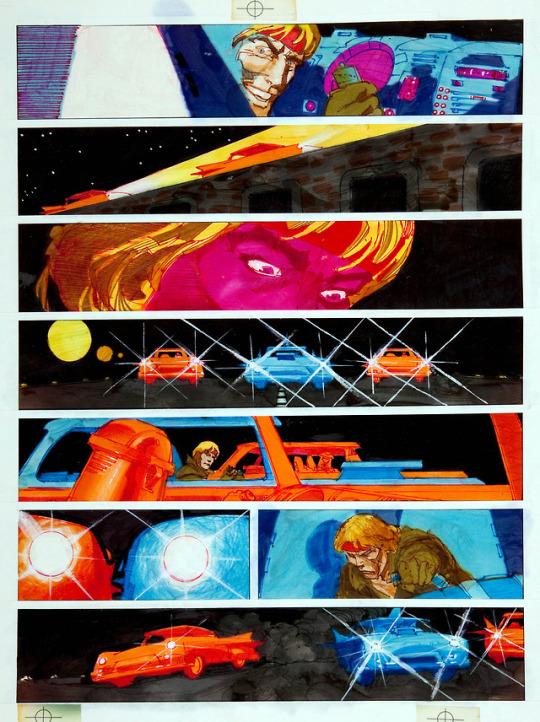
Unpublished Atari Force page by Ernie Colon, circa 1980s.
55 notes
·
View notes
Text
Creepy #14
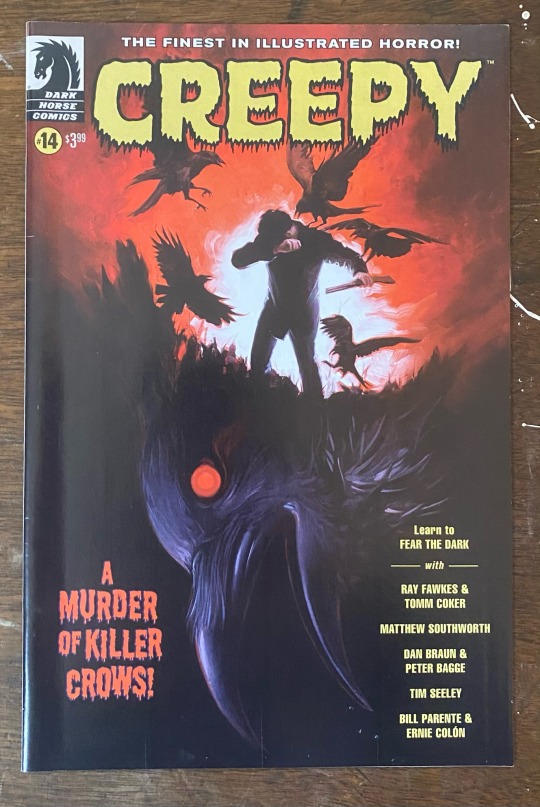
#comics books#comics#horror comics#back issues#dark horse comics#creepy#ray fawkes#tomm coker#Matthew southworth#dan braun#Peter bagge#Tim seeley#bill parent#ernie colón#David palumbo
1 note
·
View note
Text
Favorite Lightsaber Comic Panels
all stolen from my own sideblog
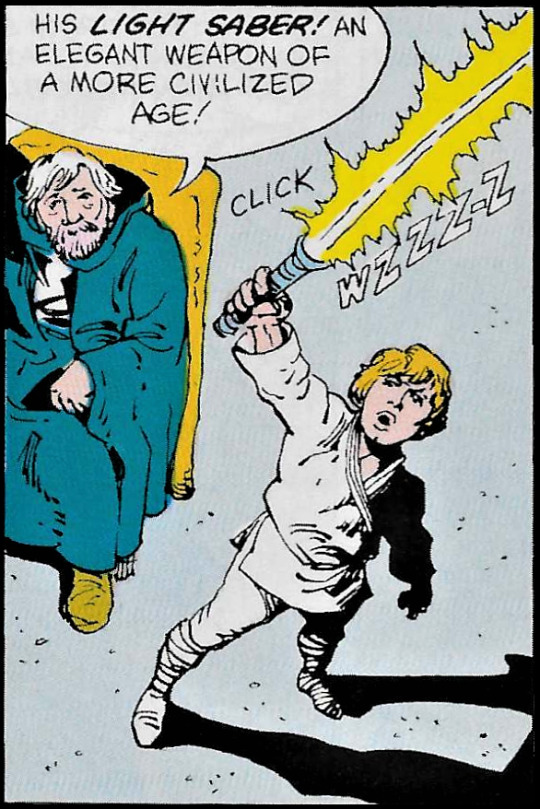
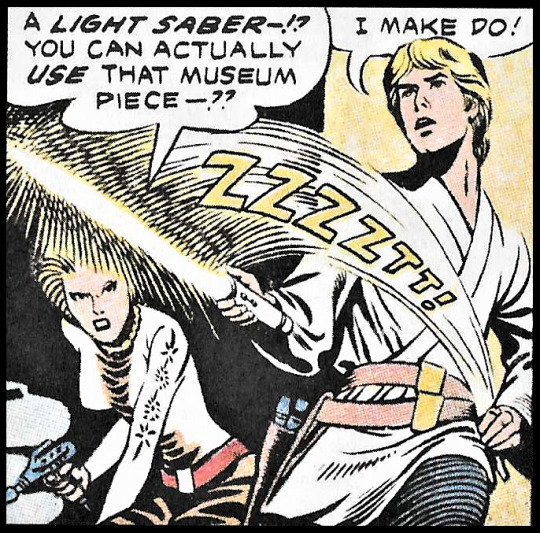
Retro fun with dynamic angles, bold shapes, and stylish onomatopoeia by Ernie Colón and Russ Manning

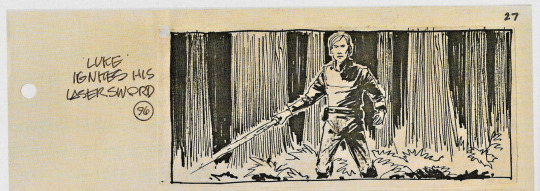
Splintering sticks by Jeff Albrecht Studios and Joe Johnston

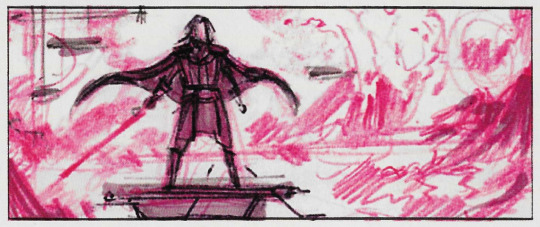
Dramatic environments with weird, energetic shapes by Andrea Broccardo and Derek Thompson
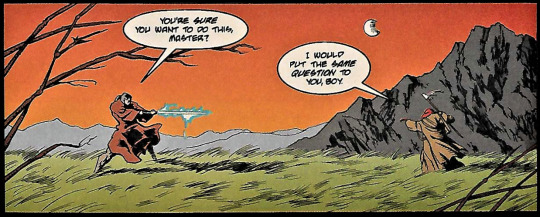
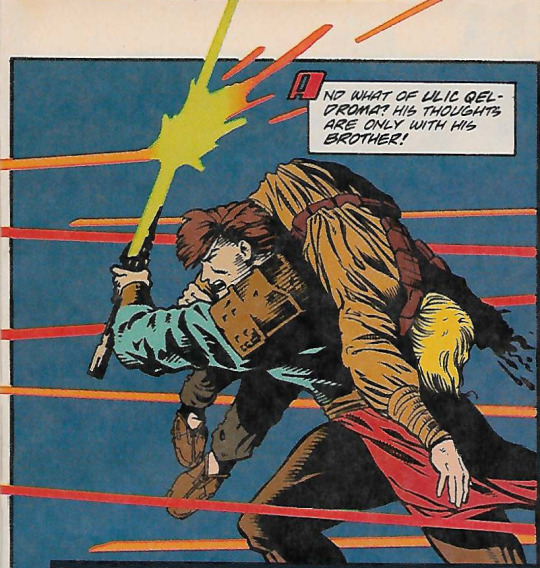
Chris Gossett's dripping popsicles, contrasted with Exar Kun's dry savannah and paralleling Cay Qel-Droma's fresh blood
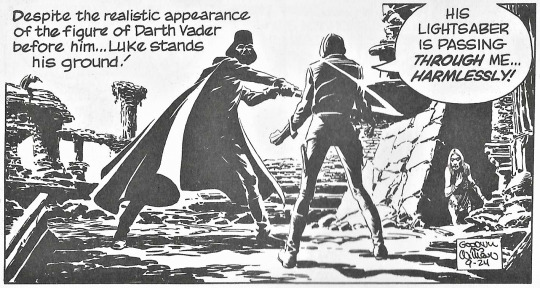
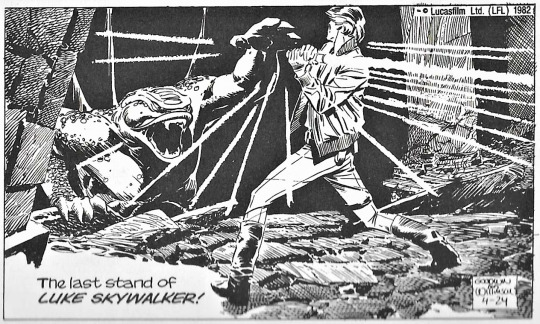
Al Williamson's masterful composition: a study in diagonals and a glorious halo of light
125 notes
·
View notes
Photo
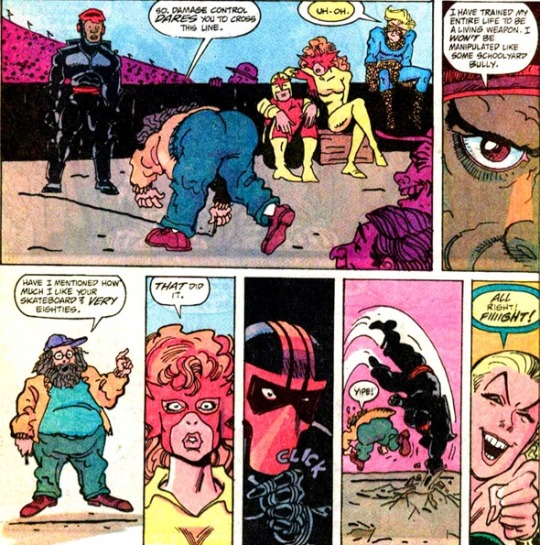
#New Warriors#Night Thrasher#Damage Control#Firestar#Namorita#Nova#Speedball#Dwayne McDuffie#Ernie Colón
9 notes
·
View notes
Text
LoSH Appreciation Week Day 5 - Time Trapper
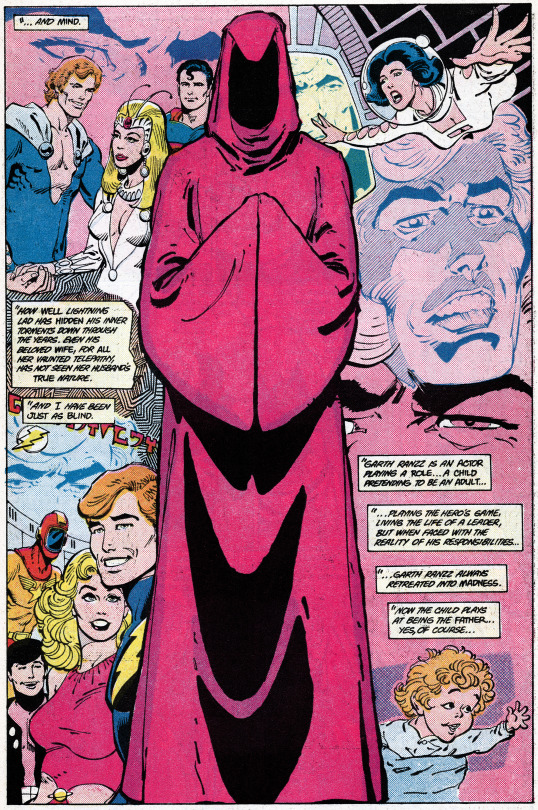
The Time Trapper is one of the trippiest, most cosmic villains the Legion face off with.

Originally, he was a science criminal who stole stuff, and had a criminal hideout in the future, untouchable due to his Iron Curtain of Time. The Iron Curtain of Time subplot lasted for over a year, but the conclusion was silly enough that there was no way of knowing that he would be brought back as one of their most powerful foes.
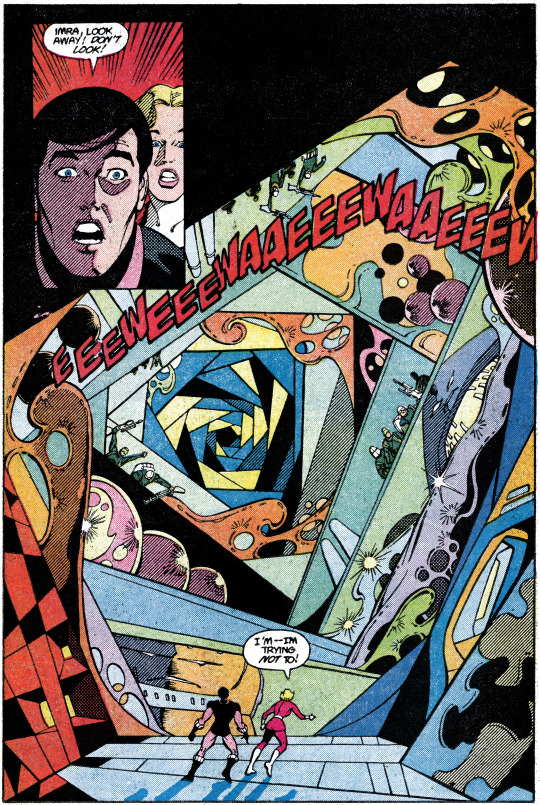
He didn’t fight the Legion again for another dozen years, but after that his development as a time manipulating super-villain really took off.

These four images by Ernie Colón and Karl Kesel are from the Legionnaires Three mini-series from 1986.
#loshweek#loshweek22#Legion of Super-Heroes#Legion of Superheroes#day 5#Time Trapper#Ernie Colon#Karl Kesel
32 notes
·
View notes